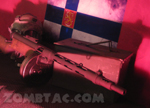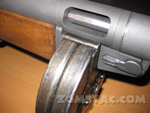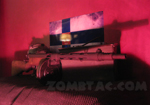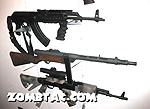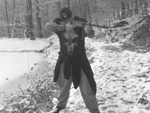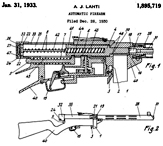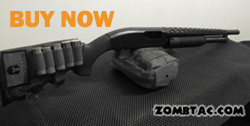Suomi M31 Rifle
The Suomi KP31/M31 was a revolutionary Sub Machine Gun (SMG) designed
and used by Finland during the WWII era, specifically in the Winter War
against Russia. It is credited as an influence to subsequent machine gun
designs
including the PPSh and others.
SUOMI M31 9mm Semi-Automatic (currently available for US purchase)
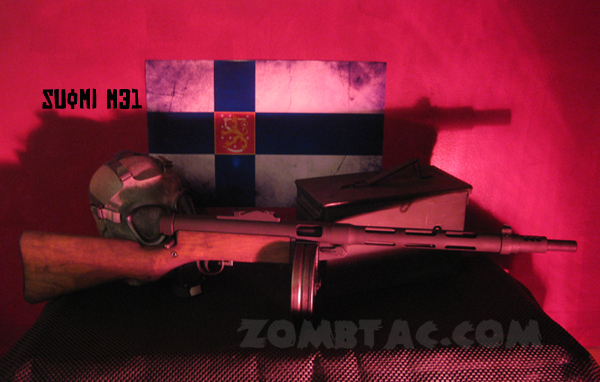
Tennessee Guns International (TGI),
of Louisville, TN, began distributing a new Semi-Automatic "replica"
version of the Suomi M31 in the late 2000s. It uses surplus Finnish
original parts and new parts such as the US-made barrel. It started
selling exclusively by Centerfire Systems of KY in the late 2000s.
TNW Firearms
Inc. of Veronia, OR also distributed this version (according to
their site, exclusively through Centerfire). We bought ours through
J & G sales and received one marked TNW, Inc, Veroina OR.
It arrived at the FFL with the bolt sticking out of the UPS box. Not
a big deal, but amusing. Upon opening it it was loose in it's original
box, in a plastic bag with a leather sling and a paper manual.
There was a scratch on the receiver above the trigger on the left side,
one that also dug into the a small chunk of the unfinished wood stock.
No problem on the stock, as it can and likely should be refinished (or
swapped with one from the readily available Suomi
M31 parts kits).
As stated the wood stock is completely unfinished, though sanded smoothly.
The metal is parkerized nicely, though leaving it prone to easy and
noticeable scratches. Traditionally, the WWII era M31s have a blued
barrel and receiver.
The rifle is built like a tank. The welds are competent, and overall
finish and fit is good. But the thing you notice is the whopping 11
pound weight (minus the magazine). The original Finnish Suomi SMGs were
made of milled parts, and at full auto the weight certainly helped with
control.
RANGE REPORT
Conditions: 39 degrees F, Partly Sunny, Occasional Gusts S/E. Snow on
ground.
This by no means is a formal range test. The M31 is more of a repro-oddball
type of rifle and would hardly be a practical choice for a modern tactical
gun or a match grade rifle.
We were more interested in its function as early production examples
(sub 800 serial numbers) have been known to have some mechanical issues.
We were also interested in the general performance of the rifle in getting
shots on paper, but did not measure out precise groupings.
We started out using Remington UMC 115 grain MC 9mm Luger ammo. We
used WWII surplus Finnish 36 round "stick" magazines. Despite
their age these magazines are generally in very good condition and are
still readily available for around a reasonable $15 each. The 9mm cartridges
loaded effortlessly into the long magazines.
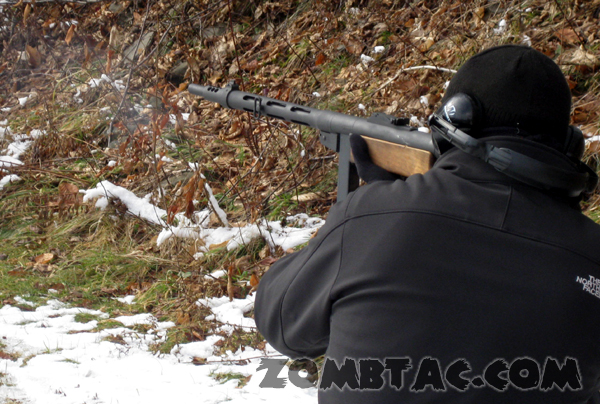
The rifle ran through 300 rounds of the 115 grain 9mm flawlessly. The
stick mags have to be seated carefully (as they often appear seated
but are not fully in), and a firm tap once they are in helps. The Suomi
performed quite well for what it is. Recoil was nonexistent as one would
expect shooting 9mm out of a nearly 12 pound solid built rifle. The
weight of the gun actually did become cumbersome over time. While there
was zero muzzle jump due to the light round/heavy rifle, it became harder
focusing the iron sights later on in the session (especially outdoors
in the cold weather), as muscle fatigue crept in and made steadying
the muzzle a little shaky (and both operators in the test were large
men over 6 feet tall, weighing an athletic 230/300# respectively).
At 50 yards the Suomi M31 hit the paper every time, maybe with a tendency
of slightly up to the right. Double taps and groupings were reasonably
tight, within an inch at times. The iron sights worked well right out
of the box. The trigger was actually fairly crisp, with just minor creep
before breaking, much better than what one would expect from a repro
kit gun like this. Length of pull on this beast was not an issue. Even
past 50 yards the M31 retained acceptable accuracy. It has a heavy US
made barrel, and while clearly not a match grade gun, it is pleasantly
accurate. You aim for a head shot or center of mass at past 50 yards
and you'll get it.
Then we switched to Speer Lawman 147 Grain TMJ and we had our first
jam. In fairness this occurred only on one magazine, so the feeding
issue may be related to the magazine itself. The rounds would feed into
the chamber quickly at an angle and get stuck that way (nicking the
brass casing). We had to clear about 5 continuous feed jams like that
until we got the mag running.
Note: No drum mags were tested but these tension loaded 71 round
drums are known to have feeding issues. (Most civilian drums in general
have issues and are hardly dependable).
Further tests will have to examine if the feeding issue is isolated to the type of ammo, a specific magazine, or the rifle mechanism itself (see known issues below).
Summary: Overall shooting the M31 was a fun experience,
and the rifle performed well and was reasonably accurate for the type
of gun it is, understanding that we would clearly not rely on this version
as a tactical or match gun. The look and history of the Suomi M31 certainly
added to the experience.
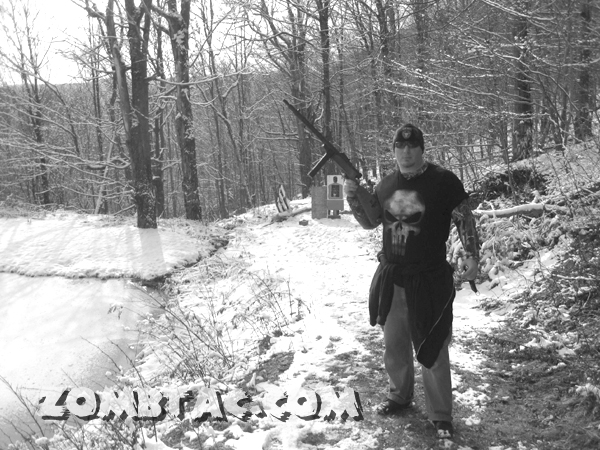
Zombtac Operator preparing to test the Suomi M31 in "Winter
War" like conditions.
NEW PRODUCTION KNOWN ISSUES
-"Short-Stroking/ Short-Cycle" Known issue with earlier production
models. (It will fire, chamber a round but the "hammer" is
not cocked. Pull the bolt back and it will fire again.) Reports indicate
TNW will take
care of the problem and their service is good for a small company.
-Bolt sticking, perhaps due to the parkerized finish (the bolt is parkerized,
unlike the original).
-Feeding Issues. There have been online reports of the Suomi M31 repro
preferring certain ammo. HP do not seem to fare well (HP did not exist
at the time of it's design).
-Drums. Generally unreliable with frequent jams reported. Tension can
be adjusted. (to be fair many commercially marketed drums on any platform
have issues).
SUOMI M31 MANUALS
- includes break-down and diagrams.
Suomi M31 Manual #1 (TNW)
(PDF) / Sumoi M31 Manual #2 (PDF)
included with the test example we received from J&G Sales.
THE HISTORIC SUOMI SMG
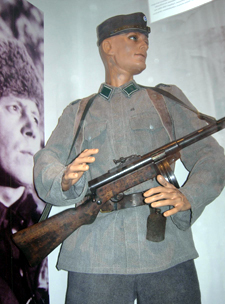 __ __ |
Suomi KP31 SMG (Historic) Country of Origin: Finland Designer: Aimo Johannes Lahti Designed: 1921 Produced: 1931–1953 Number built: Approx. 80,000 In service 1931–1998 (in active service 1980's) Cartridge: 9x19mm Parabellum Action: Straight Blowback Rate of fire: 750–900 rounds/min Muzzle velocity: 396 m/s (1,299 ft/s)[1] Maximum range: ~500 m[2] Feed system: 20, 36, 40, 50 box or 71-round drum. Weight: 4.6 kg (10.14 lb) Length: 870 mm (34.3 in) |
Wars used in: Winter War (1939-40), World War II (or the Continuation
War 1941-44), Lapland War (1944-45),
1948 Arab–Israeli War.
Nazi Germany ordered 3,042 from Finland in WWII, and likely were isseued
to Wehrmacht and SS. Also 120 Suomis were presented to the German troops
of AOK Norwegen in 1942 for use on the Finnish Front.
Sweden made 35.000 under license by Husqvarna Vapenfabriks AB just before
and during WWII, some were also imported from Finland.
Suomis were also used by the Polish Police. Other countries like Bulgaria,
Estonia, and Croatia also placed large orders during the 1940s.
Finland - The Winter War/ WWII
Finland was at war with the Soviet Union from November 30, 1939 to
March 13, 1940 (The Winter War) and then again from June 25, 1941 to
September 4, 1944 (The Continuation War).
In November of 1939, when Finland was invaded by the Soviet Union, no
one expected that this tiny nation could resist the largest military
force in the world. And no one anticipated that 1939 would be one of
the coldest winters in recorded history – a winter many historians
have described as a ‘frozen hell.’ Outnumbered and
outgunned, Finns knew this war was not about changing the borders between
nations. The Winter War involved all of Finland’s people, including
its women who organized themselves into a unique corps called Lotta
Svärd. Finland's fierce resistance changed the course of World
War II and saved a democracy.
The Winter War was a result of the major political events taking place in Europe during the 1930s. Until 1917, Finland and the Baltic States had been part of Russia for several generations. Being naturally strong willed and physically imposing, the warriors of Finland prepared for a fight, one which would take place on their soil and in their homes. Faced with the Finnish intractability, the Soviet Union finally decided to take by force what it could not get through negotiations. The Suomi M31 became the great equalizer.
The Soviet forces had three times as many soldiers as the Finns, thirty times as many aircraft, and a hundred times as many tanks. Because of Stalin's Great Purge of 1937 demoralizing the Red Army, along with a high level of inexperienced troops, and countered by high commitment and morale in the Finnish forces, along with a well-trained army, Finland was able to resist the Soviet invasion for far longer than the Soviets expected.
Original A.J. Lahti Suomi Patent Diagrams
(click thumbnail for larger image)
Simo Häyhä, nicknamed "The White Death" by the Red Army, is arguably the greatest sniper in battle history. He has the highest recorded number of confirmed sniper kills – 505 – in any major war (in about 100 days of service), using a Mosin Nagant M28 or M28/30 bolt-action rifle. Besides his sniper kills, Häyhä was also credited with over 200 kills with a Suomi KP/-31 submachine gun. On March 6, 1940, Häyhä was shot in the lower left jaw by a Russian soldier during combat, which essentially blew off half his face. He recovered and after the war became a successful moose hunter and dog breeder. When asked in 1998 how he had become such a good shooter, he answered, "practice." When asked if he regretted killing so many people, he said "I did what I was told to as well as I could."
